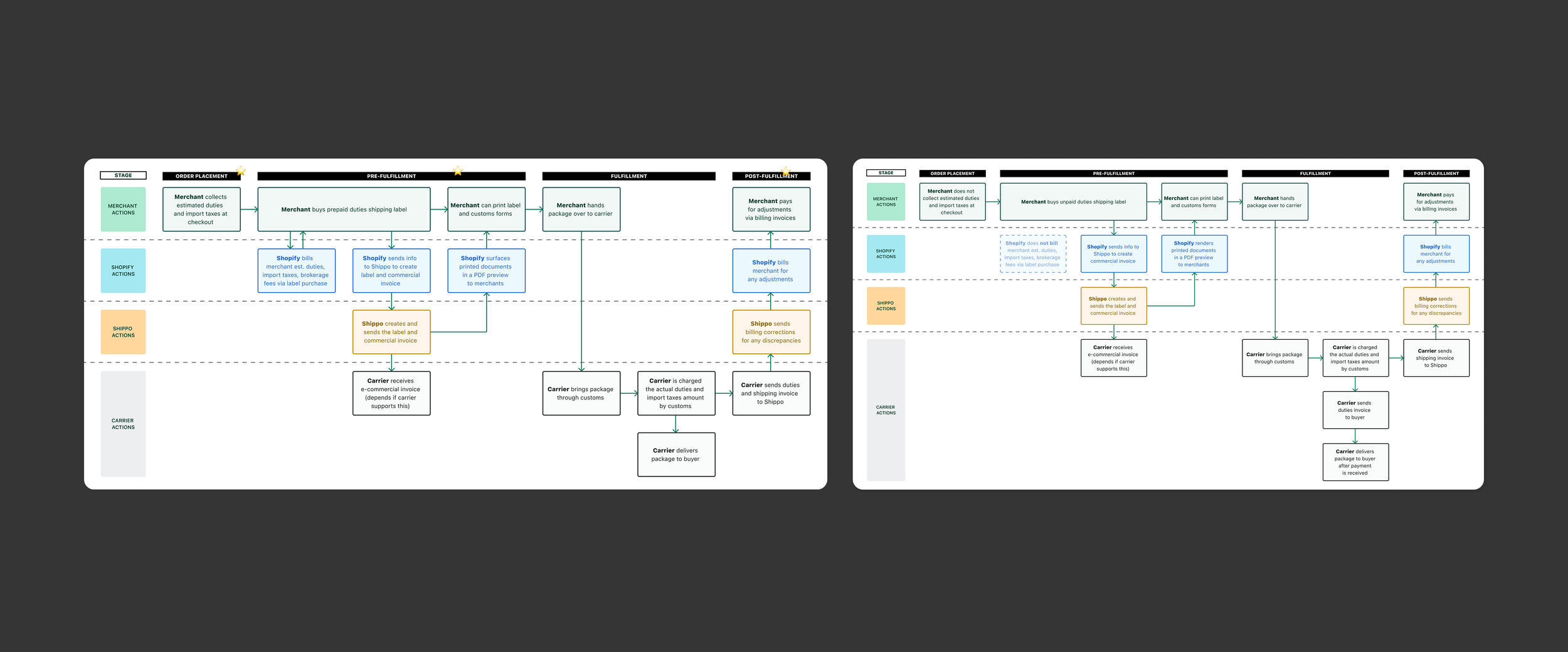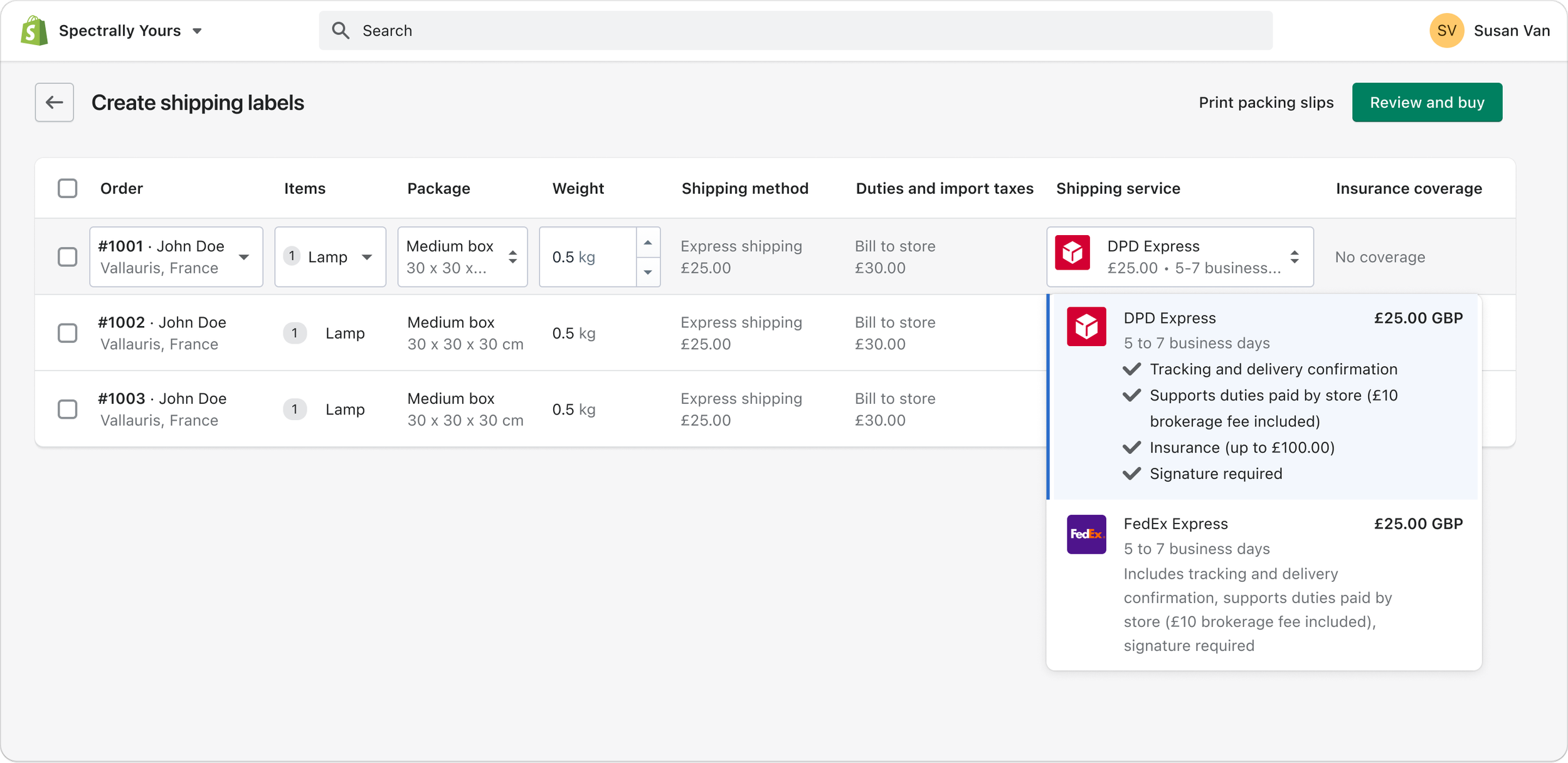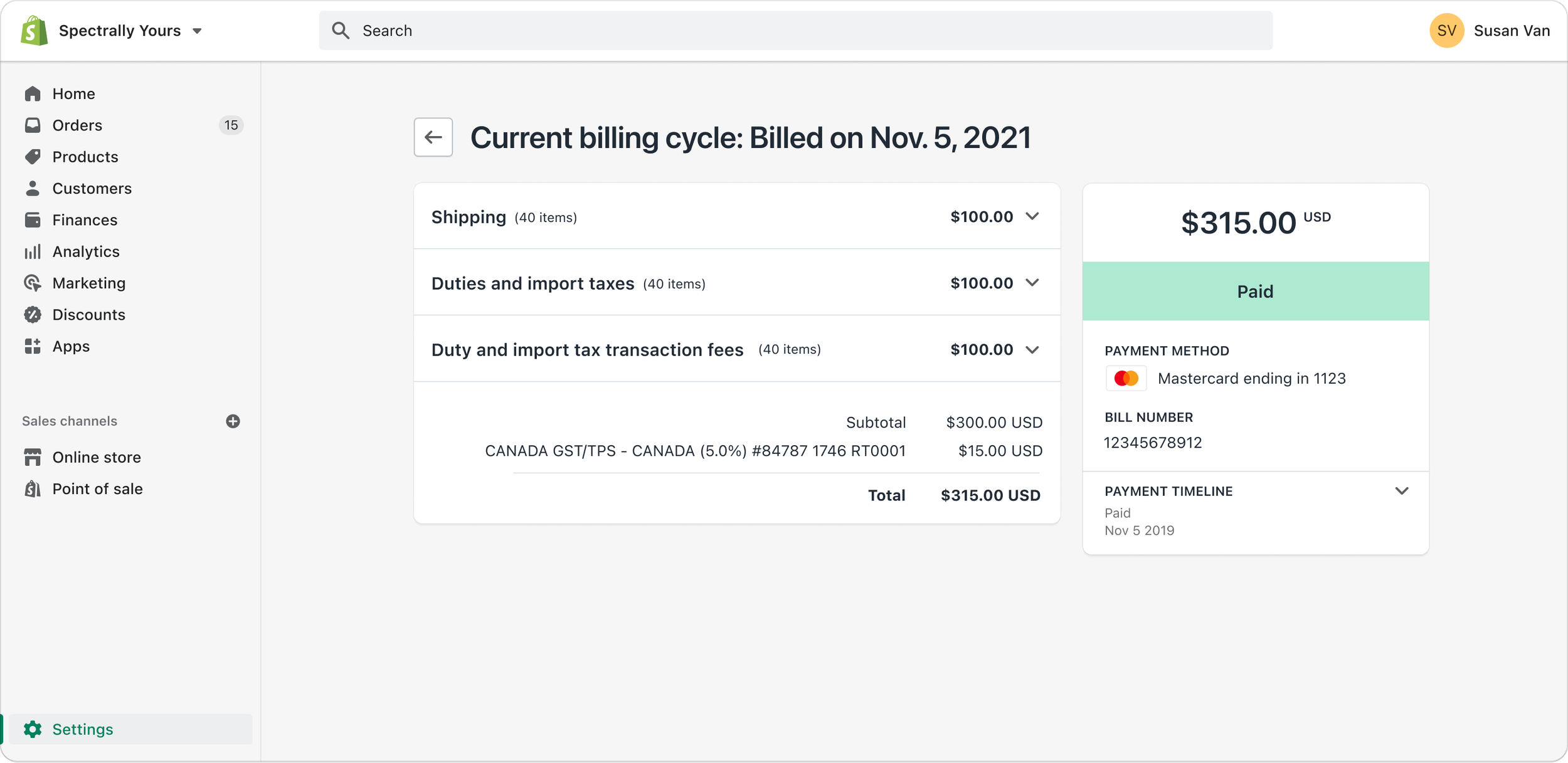Cross border shipping labels
Problem
With Shopify Shipping labels, all the shipping services offered don’t support prepaid duties and import taxes. However, Shopify merchants collecting these fees at checkout are not aware of this and there’s no way to stop them from buying these wrong labels. Merchants fulfilling with Shopify labels are unknowingly having their customers double-taxed.
Goal
Support the ability to buy shipping labels within admin for orders with prepaid duties and import taxes and design an experience where merchants are buying the proper labels for specific orders. I was the lead UX designer for this project.
Metrics
Released in Oct 2022 and sold over ~6K cross border labels worth $179K in total in just one day during Cyber Monday 2022.
Context
How do improper shipping labels affect Shopify and our merchants?
Orders with prepaid duties and import taxes need to be fulfilled with shipping services that support handling these fees.
Delivered Duty Paid (DDP) labels: Tells carrier to charge the merchant for duties and import taxes because these were collected from customer already
Delivered A Place (DAP) labels: Tells carrier to charge the customer directly for duties and import taxes because they weren’t collected yet
If these orders are fulfilled with the wrong labels, the shipping carrier will bill the customer for these fees during the shipment delivery instead of the merchant. Since the customer already paid these fees at checkout, they would be wrongfully billed twice: once at checkout and another on delivery.
This creates a negative buyer experience and reduces trust with the merchant—decreasing customer repeat orders as well as increasing support debt and refund requests. Currently, shipping services on Shopify do not support prepaid duties and import taxes. This isn’t communicated in admin at all and merchants can still purchase wrong labels for these orders. Merchants must fulfill externally on other platforms. We have an opportunity to maintain a native fulfillment experience and keep label revenue within Shopify
Existing label purchase page
Doesn’t mention anything about duties and import taxes handling at all (e.g. whether it’s applicable, what was collected) and what incoterm the shipping services support. Merchants are able to purchase improper labels for orders with duties and import taxes. There’s nothing blocking them from doing so.
Process excerpts
Some of my process images have been blurred to protect information.
I used data and conducted user interviews to understand merchants’ current fulfillment behaviours. This helped me to optimize designs and determine scope when I needed to make decisions later in the exploration phase. For example, we have two ways for merchants to create labels on platform: a label for a single order vs labels for bulk batches.
From data, some insights were:
In the bulk experience, there’s a workflow where merchants can change the shipping service across multiple orders. I found out that merchants use this multi-select workflow for only 1.57% of bulk orders. This is a very low percentage, so we knew we could implement changes to this workflow last since it wasn’t a popular method for merchants. This helped us to figure out priorities.
Merchants have the flexibility to batch together a mix of orders in the bulk experience. I wanted to see what merchant’s typical behaviours were when fulfilling bulk orders. Although ~92% of batches were purely domestic or cross border orders only, there was ~8% of batches that had a mix of domestic and cross border orders. I had to make sure that the design would be flexible to accommodate this mixed situation since duties and import taxes is only applicable to cross border orders.
I did competitive research to see what language merchants were familiar with and features that were supported on other platforms.
Two insights that I found were:
Incoterm selection is positioned as who is paying for the duties and import taxes instead of the actual delivery agreement. Some of the terms were Sender & Receiver, instead of DDP and DAP. This makes it clear on who is paying since merchants may not be familiar with formal terms.
Merchants had the choice to subsidize duties and import taxes. For unpaid duties orders, merchant can set the the label to either be DDP or DAP on a specific order if the merchant wants to subsidize the fees. They could also set this at the account level for all cross border orders.
I created flow charts to map out the workflows to share context and align internally. This gave an overview of all the touchpoints we needed to change (e.g. orders, shipping labels, billing invoices), external processes (e.g. partners, shipping carriers) and the teams we needed to align with (e.g. 4 teams in total).
I explored two high-level directions and conducted usability testing before aligning with stakeholder teams and senior leadership on my recommended direction. I recommended creating a new, separate section because it was clearer to merchants if the store would be invoiced for duties and import taxes or the customer. When it comes to matters of money, clarity was important to merchants.
Some merchants also expressed interest in being able to subsidize for duties and import taxes on unpaid orders. This sentiment matched with the insights I found from my competitive research earlier. I future-proofed the designs by testing how the two directions could evolve if we were to support this subsidization feature. The conclusion was that having a new section would make it easier for us to support this feature in the future and be a future-proof design.
When a partnership contract fell through and we had to pivot our product strategy, I quickly adjusted the designs so that we could still deliver a beneficial ux experience. We weren’t able to provide prepaid label orders yet because of the contract fall-through, so I designed a descoped experience that we could ship first. At the very least, we should explain to merchants:
Orders with prepaid duties and import taxes need to be fulfilled using external apps as our current Shopify Shipping services didn’t support this. Changes were to block the buy button, add a banner for context and don’t show any shipping services. This helped to prevent merchants from double-taxing their customers.
Reassure merchants that the current shipping services were suitable for fulfilling their orders with unpaid duties and import taxes. Changes were to include context that the customer would be charged these fees on delivery and provide handling detail within the service info itself.
Final designs
This is excerpts of what we shipped as the full experience when we were able to obtain partnership contract.










